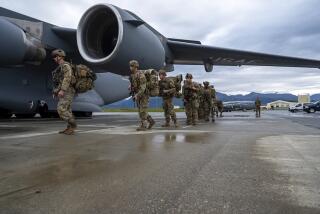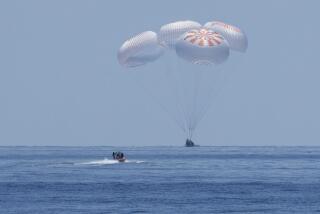Navy to Roll Out the Red Carpet as Soviet Warships Visit San Diego
- Share via
The U.S. Navy will welcome three Soviet navy ships when they arrive Tuesday morning at the 32nd Street Naval Station, where a traditional Soviet ceremony will kick off a 5-day visit to San Diego.
The visit--the first time Soviet military vessels have docked on the West Coast--is the latest in a series of reciprocal exchanges that brought another Soviet navy contingent to Norfolk, Va., last July.
The visit--intended to foster goodwill--will “improve dialogue, understanding and confidence” between the United States and the Soviet Union, said Vice Adm. John Fetterman, commander of the Pacific Fleet’s naval air force.
Highlights of the pageant-laden week will include a visit to the U.S. Grant Hotel Tuesday night, where the Soviet Song and Dance troupe will perform; trips to Sea World and the San Diego Zoo; a flight demonstration at Miramar Naval Air Station; and a rodeo at Camp Pendleton.
The most somber event occurs Wednesday afternoon, when the Soviet contingent, led by Pacific Fleet commander Adm. Gennadij Alkesandrovich Khvatov, will lay a wreathe at the Rosecrans National Cemetery.
A very lucky and relatively small number of San Diegans, judging from the demand for free tour tickets, will be allowed to board one of the two visiting destroyers, the Admiral Vinogradov or Boyevoy, that will be docked at the naval station’s Pier 2. An oiler, the Argun, will also be docked there.
According to Lt. Cmdr. Bob Pritchard, a Navy spokesman, the 8,000 tour tickets were given away in 1 1/2 hours Tuesday at San Diego Jack Murphy Stadium.
The Navy, which had set up a temporary booth in a Marine Corps recruiting vehicle, said they had to turn many people away. Some had waited in line from 6 a.m. to 11 a.m. for a chance to secure tickets.
“They went as fast as we could hand them out,” Pritchard said.
Tours are from 12:30 p.m to 5:30 p.m. Tuesday and from noon to 5 p.m. Wednesday through Friday. Visitors are allowed to bring cameras aboard.
Pritchard recommended that people taking the tours travel by trolley to the Pacific Fleet stop, but he said parking will be available at 32nd and Main streets.
Aside from the tours, the best chance to see the Soviets will be during their visits to Sea World and the San Diego Zoo Wednesday and Thursday afternoons.
The Soviet Song and Dance troupe that will entertain at the invitation-only Tuesday night reception will perform at several locations throughout the week, with all shows free and open to the public.
Wednesday afternoon, they will be at Sea World’s City Streets from 12:15 to 1:15; Thursday they will perform at the Balboa Park’s Spreckels Organ Pavilion from noon to 1 p.m. and later at San Diego State University’s Open Air Theatre from 6:30 p.m. to 9 p.m.
Friday, they will be back at the Spreckels Organ Pavilion from noon to 1 p.m. and at Tidelands Park in Coronado from 7:30 to 9:30 p.m.
Only about 300 of the 800 Soviet sailors making the trip will leave the pier during any single excursion.
Those staying behind will mingle with U.S. sailors from the guided-missile frigate McClusky, the guided-missle cruiser Leahy and the destroyer Merrill, which are the host ships.
Adm. Charles Larson, commander-in-chief of the Pacific Fleet, is the visit’s official host.
On the surface, it’s mainly “a social call,” said Benjamin Lambeth, a Soviet expert with the Rand Corp., a think-tank which does work for the military.
But these visits are significant, he said, because while civilian exchanges occur, the military-to-military meetings allow both sides to penetrate the hyperbole and stereotypes that dominate attitudes about the more secretive military segments of each society.
“We’ll get to see them first-hand. It has the effect of breaking down the stereotypes people have,” said Lambeth, director of the international security and defense policy program at Rand.
Lambeth likens the visit to one he made to the Soviet Union, where he flew in the Mig-29 fighter.
“It was a real three-dimensional, hands-on perspective. It makes you gain respect for your Soviet (counterparts),” he said. “(Meeting them) is certainly better than reading about them.”
The groundwork for the visit was laid in 1988 by Adm. William Crowe, former chairman of the Joint Chiefs of Staff, and by former Soviet chief of staff Marshal Sergei Akhromeyev, who is now national security adviser to Soviet President Mikail Gorbachev.
In addition to the Soviet visit to Norfolk, Va., U.S. ships visited the Black Sea port of Sevastopol last August, and in September, U.S. Pacific Fleet ships will visit Vladivostok, the Soviet Union’s chief Pacific port.
According to Pritchard, off-base security for the visitors will not be unusual. He said the Soviets’ escorts will also double as their security.
“Overall, I can characterize the off-base activities as the Soviets being teamed up with their host ship sailors and a cadre of interpreters.”
Additionally, he said, the San Diego Police Department and the security personnel at each event will play large roles.
Pritchard said the Navy office responsible for coordinating the press alone has been staffed with 40 people who were expecting about 200 journalists from across the country to attend.
“We’ve been meeting since (since June) . . . on a regular basis to get ready for this,” he said. He estimated “several hundred” Navy personnel had been directly involved in the planning and execution of the visit.
Navy officials are aware that several groups--ranging in diversity from the John Birch Society to Greenpeace--are considering plans to demonstrate during the visit.
“We live in a free and democratic society and that’s their right,” said Pritchard.
“Should they decide to express those rights we hope they will do so in a manner consistent with the law,” he said.
One San Diegan anticipating the Soviet arrival is Lowell Strombeck, president of Citizen Diplomacy of San Diego, who visited Vladivostok last month with a group of local artists.
There they received an unusual invitation.
The officers of the Boyevoy, who had heard the San Diegans were in the city, called on them to come aboard the ship. There, said Strombeck, they were quizzed about San Diego.
“They asked us a lot of questions about San Diego,” he said. “They were really quite excited about their trip.”
Among other things, he said, the officers were curious about Mayor Maureen O’Connor and about what kind of clothes they would need to take.
Strombeck said he sensed the visit to San Diego could be particularly timely for the Soviet officers, from whom he got the impression were having to adjust to interacting with a freely elected civilian government in their home port.
“I think they’ll be asking the Navy all kinds of questions about what it’s like to relate to a government that’s freely elected,” he said.
“It’s a whole new ballgame for them now.”
More to Read
Sign up for Essential California
The most important California stories and recommendations in your inbox every morning.
You may occasionally receive promotional content from the Los Angeles Times.













